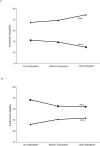Integrated schools, segregated curriculum: effects of within-school segregation on adolescent health behaviors and educational aspirations
- PMID: 20634462
- PMCID: PMC2920985
- DOI: 10.2105/AJPH.2009.179424
Integrated schools, segregated curriculum: effects of within-school segregation on adolescent health behaviors and educational aspirations
Erratum in
- Am J Public Health. 2011 May;101(5):775
Abstract
Objectives: We examined the extent to which within-school segregation, as measured by unevenness in the distribution of Black and White adolescents across levels of the English curriculum (advanced placement-international baccalaureate-honors, general, remedial, or no English), was associated with smoking, drinking, and educational aspirations, which previous studies found are related to school racial/ethnic composition.
Methods: We analyzed data from wave 1 of the National Longitudinal Study of Adolescent Health, restricting our sample to non-Hispanic Blacks (n=2731) and Whites (n=4158) who from 1994 to 1995 attended high schools that enrolled Black and White students.
Results: White female students had higher predicted probabilities of smoking or drinking than did Black female students; the largest differences were in schools with high levels of within-school segregation. Black male students had higher predicted probabilities of high educational aspirations than did White male students in schools with low levels of within-school segregation; this association was attenuated for Black males attending schools with moderate or high levels of within-school segregation.
Conclusions: Our results provide evidence that within-school segregation may influence both students' aspirations and their behaviors.
Figures

References
-
- Osypuk TL, Acevedo-Garcia D. Are racial disparities in preterm birth larger in hypersegregated areas? Am J Epidemiol. 2008;167(11):1295–1304 - PubMed
-
- Robert SA, Ruel E. Racial segregation and health disparities between Black and White older adults. J Gerontol B Psychol Sci Soc Sci. 2006;61(4):S203–S211 - PubMed
Publication types
MeSH terms
Grants and funding
LinkOut - more resources
Full Text Sources
Medical

